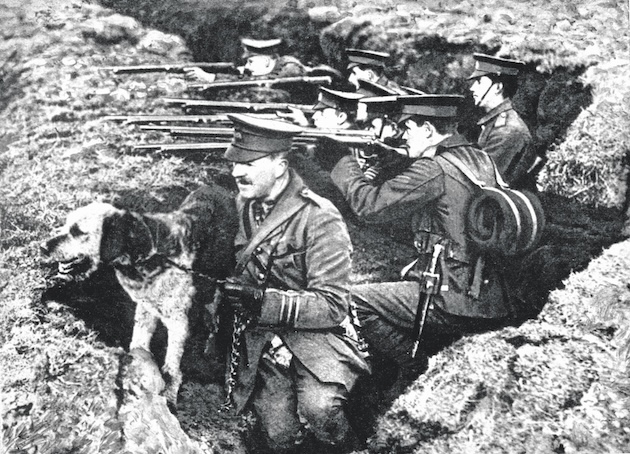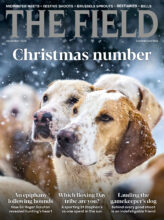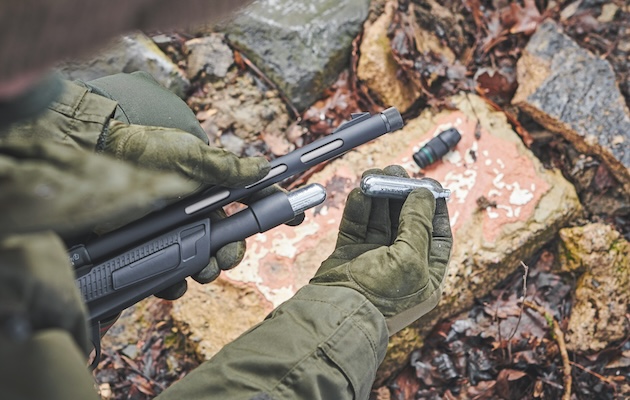For many of us, the humble air rifle has provided a gateway into shooting sports but how did Britain become a world leader in airgun development?
Airguns have always had a slightly subversive image. Their stealth made them ideal tools for poachers, and in the past many windows have been broken by stray pellets. Lots of us learned to shoot with airguns and they have wormed their way into our subconscious. For example, British Army squaddies used to call their SA80 rifles ‘Gats’ after a particularly ineffective push-barrel air pistol produced in Walton-on-Thames from the 1930s until the mid-1990s. (Read Airgun Guide: What to shoot and what to buy)

The Birmingham Small Arms factory, Small Heath, Birmingham, February 1917.
Airgun development in 20th century
It was at the beginning of the 20th century that air rifles took a more prominent place in British affairs by helping us prepare for war. They turned the British Army from soldiers who couldn’t hit the broad side of a barn into accurate and efficient marksmen. After the disastrous showing of British riflemen in the Boer War, Lord Roberts made a call to the nation to take up rifle shooting and many new shooting clubs were formed. Airguns were an accessible and inexpensive way to train all people to shoot for the defence of the Empire. British companies such as Webley & Scott and the Birmingham Small Arms Company (BSA) made many rifles for this purpose. These airguns were not military rifles in the strict sense of the word, in that they weren’t ordered in large numbers by the British Army, but they were used by clubs such as the National Small-bore Rifle Association and what is now the Preparatory Schools Rifle Association. (Read: Top 10 airguns for use in the field.)

A BSA advert, circa 1914. The air rifle was a vital tool for learning marksmanship at home.
BSA air rifles
BSA air rifles using the Lincoln Jeffries patent started to be manufactured in 1903 and had levers under the fixed barrel (underlevers) to cock the mainspring, with the pellet being inserted into the breech via a loading port with a tap action. Webley & Scott introduced its Mk II air rifle in 1932 and it utilised a break-barrel action with a superimposed barrel locked by a bolt action. It became known as the ‘Service rifle’ but this is a bit of a misnomer because orders from the military never materialised. However, the rifle was a success on civvy street and remained in production until 1945.

Innovation in air-rifle technology was a hallmark of Britain brands
Improved marksmanship
How did the humble airgun have such an impact on improving the marksmanship of the British Empire in two world wars? Airguns are totally different from fullbore rifles and military weapons but the same principles apply. Even today, if you want to improve your marksmanship, it’s a good idea to practise with a spring-powered airgun. One can see why the British Expeditionary Force at the outbreak of the First World War were such feared marksmen. Before becoming soldiers, many of these men would have learned to shoot through the various civilian clubs using air rifles made by Webley & Scott and BSA.

Webley & Scott’s MKll air rifle, which became known as the ‘Service rifle’ was introduced in 1932 and remained in production until 1945
New airgun designs
More recently, Britain has also proved remarkably adept at pioneering new airgun designs. Spring-piston airguns were the norm in the first part of the 20th century but other sources of power were explored, such as the gas-ram, carbon dioxide (CO2) and pre-charged pneumatics (PCP).
The gas ram was also a British invention; the work of Ben Taylor and his business partner, Dave Theobald. Unsatisfied with spring-piston airguns that would not retain the power and accuracy required, Taylor had the idea of using cars to hold the boot open. The result was an airgun that resembled a conventional break-barrel springer but was powered by compressed nitrogen in a gas strut. Taylor applied for the patent in 1981 and production got under way at Taylor and Theobald’s own firm, Theoben. Gas-rams have several advantages over spring guns: they can remain cocked for any length of time without losing power; they have a faster lock time (the time from pulling the trigger to the pellet exiting the muzzle of the rifle); they require less maintenance; and the parts are more durable.

The British Expeditionary Force, many of whom learned to shoot with air rifles, were feared marksmen
Ingenious system
Another great British innovation was the air cartridge system. Invented by British company Saxby-Palmer and perfected by Brocock – yes, another British outfit. The Brocock Air Cartridge System (BACS) was essentially a mini air reservoir made of brass that was charged by use of a pump or divers bottle and a cone, which holds the pellet, screwed on to the nose. These cartridges were loaded into various replica revolvers made by Brocock. It was an ingenious system and filled the gap after the UK handgun ban in 1997 but fell foul of legislation itself when some criminals converted these pistols to use live rounds. This resulted in the Anti- Social Behaviour Act 2003 and thousands of law-abiding airgunners had to surrender their Brocock BACS pistols or get a Section 1 firearm certificate. Happily, Brocock diversified into CO2-powered replica airguns and PCPs. It is now a sister company of Daystate and its airguns are still made in the UK under the name BRK.

The FN19, an early PCP from British airgun brand Falcon, being used for pest control
PCP airguns
Finally we come to the pre-charged pneumatic (PCP), which has an air reservoir charged by use of a pump or a divers air tank. It is not a new invention or a British one. However, it wasn’t until the late 1970s that Daystate began designing and making PCPs on a large scale. It was quickly followed by other British companies, such as Air Arms and Sportsmatch, and thus began the airgun arms race that is still going on today.
Daystate has been on the leading edge when it comes to technology, with brilliant innovations such as electronic triggers, digital displays and air regulators fitted as standard. The Delta Wolf, launched in 2020, is the company’s flagship airgun. “It’s the most technically advanced rifle full stop. And that includes full-bore rifles,” says Tony Belas from the firm. It has variable power outputs, so you can maximise shots per charge of air, as well as interchangeable calibres and an electronic trigger. Using an electronic trigger compared with a conventional trigger is rather like releasing a shot with the click of a computer mouse. “You don’t get this kind of technology until you get to a Challenger 2 tank,” insists Belas. Daystate is no longer British-owned; it was bought by the Diana Group in 2008. “We leave the design to the Italians, as they have the flair, but we build and develop the rifles in our Staffordshire factory because that is what we excel at,” says Belas.

BSA has been proeucing airguns at its factory in Birmingham since 1861
Not to be outdone by Daystate, Air Arms has come up with many new ideas in its time. It holds the distinction of not only producing airguns in the UK but is also the only airgun manufacturer to be Britishowned. The company also owns Falcon (another British airgun brand) and produces a wide range of airguns, including springers and PCPs. One of its best-known innovations is using Delrin synthetic bearings for reduced friction on its underlever spring-powered airguns such as the Pro Sport. These are self-lubricating, incredibly hard-wearing and give the cocking mechanism a silky feel. Combine this with the Air Arms CD trigger, which was designed to rival German airgun manufacturer Weihrauch’s Rekord trigger, and you have a beautifully engineered and accurate spring-powered airgun. Air Arms still designs and produces airguns in its East Sussex factory. The only parts not made by the company are the barrels, which come from Lothar Walther, and some of the stocks are from Italy.
I have an Air Arms S410 classic PCP that airgun maestro Ben Taylor (the inventor of the gas-ram system) modified a few years ago. At that time he was working on his new invention, the ‘smooth twist’ barrel, which was made in the UK and designed to give accuracy and efficiency. Instead of having rifling all the way down the barrel, the smoothtwist barrel only has the last section of the barrel swaged from the outside, so it gives the pellet a twist to keep it stable at the last moment and the pellet comes out of the barrel with little change to its structure, making it supremely accurate. The smooth-twist barrel design is now used by Swedish airgun manufacturer FX. I didn’t have my Air Arms air rifle decked out with British-made extras such as the smooth-twist barrel, Huggett moderator and Sportsmatch mounts because I’m a raving jingoist. I had it modified because the components used were, in my opinion, the best in the world.
The ‘big daddy’
Now we come to the ‘big daddy’ of the British airgun world. BSA has been producing airguns from its Birmingham factory since 1861. Unlike Air Arms, BSA is no longer British-owned since it was bought by the Spanish firm Gamo and sold to an American investment group in 2013. The firm has survived so long because it never rests on its laurels. “The modern airgun shooter is always looking for the next best thing, so we have to provide that for them,” says Jon Hatton from the company.
Two new break-barrel springers – the Comet and Meteor Super – are now being made back in Birmingham, having been produced overseas for decades. Why? “Continual feedback from customers was, ‘I’d buy one if you made them in Brum’, so we thought we’d test that theory,” says Hatton. “We are proud to still be here after 163 years in the same factory, not just surviving but thriving in the UK and exporting all over the world.” These models, despite sporting traditional names, have upgrades such as synthetic stocks and improved triggers. BSA is the only British-based company to produce break-barrel springers and these join a host of more technically advanced PCP airguns also made in the UK. It is also the only UK air rifle manufacturer to make its own barrels.
“I think we Brits lead the world in airgun technology because in the UK the airgun has never been a toy. In the USA, where laws are different, you will give an airgun to a nine-year-old. In the UK we have escaped draconian laws and managed to create sub-12ft/lb airguns that are powerful enough for sporting purposes. Many of our customers have never touched any other type of gun, because they don’t need to,” says Daystate’s Belas.
“If you look at the past 100 years of airgun evolution, the UK is definitely among the world leaders,” confirms Hatton. We are a small island yet these airgun companies – Air Arms, BSA, Daystate and many others no longer in existence – have contributed more to airgun innovation than any other nation in the world.





